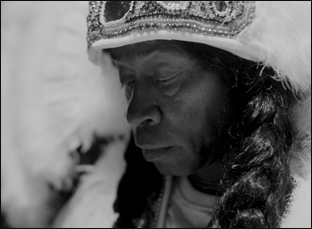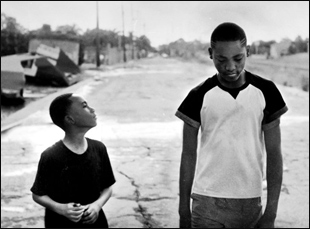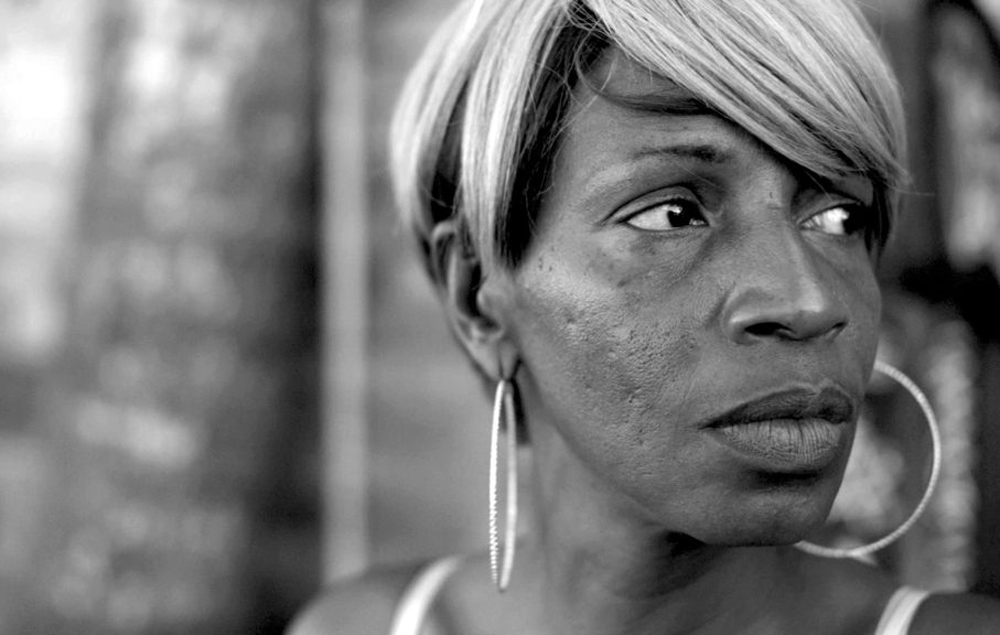Recently, Roberto Minervini was invited to speak on a panel in Rome regarding the issue of race, given that the Italian-born caucasian filmmaker had embedded himself in an African-American community to make “What You Gonna Do When the World’s on Fire.” He was uncomfortable about the situation to begin with, already having to reconcile his interest in elevating the voices of African-Americans without being African-American himself before taking the film on, but his nerves were calmed slightly since he would be accompanied by Judy Hill, the indefatigable owner of the Ooba Dooba Bar in New Orleans who serves as one of the film’s central figures. Still, looking over the assembled speakers, including historians who could only speak of race at a remove both in terms of time and experience, Minervini couldn’t stand to be there any longer.
“They started speaking with that top-down approach, speaking on behalf of the black community, lecturing people about life in Alabama today, so when I heard the intellectualization of the issue, I left,” recalled Minervini. “We can’t continue to preach from our standpoint. And Judy was there, speaking from the heart, and she spoke her truth with her language and I’d rather listen to Judy rather than myself speaking about this film.”
He adds, “This been the hardest thing I’ve ever done in film because it’s very, very hard to be stuck in the middle – the intermediary, to be the white guy talking about on behalf of some people with whom I shared a profound experience and with some of whom I share a friendship yet I don’t share their socioeconomic condition. So to speak around the world on their behalf is something I struggle with.”
The weight Minervini carries actually makes the camera feel lighter in “What You Gonna Do When the World’s On Fire,” where the crisp, fluid scenes document a community still reeling from the recent police shooting of Alton Sterling in 2016 makes the filmmaker’s presence seem all but invisible, though it’s clearly the work of someone of great skill and sensitivity, the result of the work Minervini’s been doing since 9/11 necessitated a change in careers and he was compelled to look deeply into the underlying issues that lead to hatred. There is no “other”-ing in his latest film, which takes great pains to allow its participants to speak directly to audiences in any number of respects.
Of the many extraordinary moments in the film, one involving a community meeting in Hill’s bar during its off-hours is particularly electrifying, as Hill leads a discussion of the mistreatment of African-Americans that’s been present throughout history and it is clear there is no hierarchy as the camera is guided by the frenzied energy of the conversation, drifting back and forth across the room, giving everyone who speaks a central focus and the time to be heard. (“That was one of the first things I filmed actually, recalled Minervini, of his time spent in the Bayou in 2016. “And what I captured there is that energy that was bottled up [of all these people] that wanted to talk. Judy was telling me, ‘We want to talk, we want to be heard. That was like a starting point for us to trust each other and get along — when you can speak up, we can talk and you can listen.”)
Naturally, it was a series of conversations with various members of the community that opened up “What You Gonna Do When the World’s on Fire” to properly capture the experience of the cultural moment, which Minervini distills into three separate tracks, following Judy as she struggles with keeping her bar open; Reinaldo and Titus, a pair of young brothers idling the days away doing what boys do, yet engaging in decidedly adult conversations where the older Reinaldo prepares Titus to what to watch out for as a young black man in America, and the New Black Panther Party for Self-Defense as the mount spirited protests in the streets to respond to Sterling unjust death. The connections between these threads are loose, but strong – besides being geographically linked, they showcase a resiliency that has been passed on between generations as much as the inherited trauma from being a continual subject of persecution – and you could describe Minervini’s entire body of work as a whole similarly, first relocating to Texas to tell the story of a young woman running up against the strictures of her religious family in “Stop the Beating Heart” and moving east to Louisiana to find an impoverished Caucasian community that the country seems to have left behind in “The Other Side,” leading to drugs and guns to become a central pastime.
After observing all the ways history can hold America back, the filmmaker has created vital portraits of people and places worth fighting for and engages audiences as if the films aren’t only a means of preserving a moment, but alive with possibility for the future. With the film arriving in its country of origin after a celebrated festival run around the world, Minervini spoke of the huge responsibility he felt in conveying the experience of the community he was covering, finding the right people to follow and why he was so happy about what happened at the local premiere of the film.

Yeah, the timing was influenced by several factors. One is definitely the political climate of the United States [where there’s] this resurgence of the lack of trust towards the government and the anger of people. Then I thought it was time to go and explore the situation of black America as we were at a crossroads, transitioning from the Obama Administration to a new chapter of America — a way darker one, in my opinion. So that was one factor, but also the fact that I didn’t feel on par to the task of going to tell a story like this or being of service to the African-American community before doing “The Other Side.” I was still intimidated by the challenge of carrying such a burden, telling a story of such magnitude. “The Other Side” is my first film venturing into something extremely political and also intrinsic to America and the American South. That was the first time I really dove headfirst into something so big, so you could say that was a training ground for me to approach and tackle a bigger topic like I do in this film.
[And for “What You Gonna Do When the World’s on Fire,”] I told them that I come here with a lot of fear because my fear is informed culturally. I’m supposed to fear where I am right now in a black neighborhood with high crime and I’m white, so I was saying, “I come here as someone who really wants to listen and [has] a personal need to listen because I want to be a better man, so speak your truth. I’m in service of the truth because really that’s all I want. And I think that was really liberating for them for someone to say, “Look, I’m flawed. I belong to white society, but I really badly want to understand and take you very seriously.” They felt like they were taken very seriously and I gave them the dignity to speak up and that’s how I approached the whole film really.How did you find Judy?
In a way, Judy was just the starting point of the project because when I was thinking about working on this film, the first thing I thought was to go back and explore the roots of black music, which is deeply connected to African music. I knew Judy Hill through friends and I knew the Ooba Dooba Bar where Judy and her cousin James Andrews, a prominent jazz trumpet player in New Orleans, were performing on Wednesday, so we’re there on a Wednesday and I continue to go there for a long time — months and months — until I got to know Judy very well. We started hanging out and then I decided I had a feeling that she would be the catalyst perhaps for the whole film.
Did the idea of music continue to inform the film, even if it didn’t become a focus?
Yes, Judy is a queen of the Mardi Gras Indian tradition, so I got to know the Indians and then my interest diverted from more anthropological approach to music — the blues and the folk blues before — and it moved into something much more organic. The Indians brought the musical aspect of their culture into the film and that’s really how the film embraces that aspect of the music in the culture. Those chapters or sequences in the film almost work as intermezzos [where] they pace the film and to remind us through the oral tradition that the story I’m trying to tell is tied to something old and ancient.

Yeah, even before I knew what kind of film I was going to make, I knew I was going to make a film about African-Americans in the south and I knew that I was going to make a film about parallel stories. I didn’t want these stories to cross over or converge at some point, [but would work] on different levels. So I wanted something that visually immediately brought us back to the most important period of contemporary black America, which is the civil rights movement, and to create an iconography and a continuum with that time immediately. And two, I knew that if I wanted to work with several people, with several communities, I wanted to approach them democratically, so by eliminating all those jumps in color, [which are] schizophrenic sometimes because we change constantly place and time, I knew that I could make it to create some equanimity, representing several stories.
Did you know you’d be filming in such a charged environment?
Yes, and I was scared of it. I was really afraid. I felt extremely vulnerable [with] this shame of being there as a witness to something that deeply scarred a community. If you remember in 2016, [the police] killed Alton Sterling in [Baton Rouge] and then they killed Philando Castile a few days after and then aa young black man killed three policemen in Dallas for retaliation, so it was hard to witness all that. A year after that, there I am with the [memory] of Alton Sterling and the wounds were still open, the pain was so strong and the anger was brutal and I felt extremely inadequate to be there. That’s when the self-doubt really started kicking in.
I thought the only way of really finishing the film and being able to cover this part is really to let go of control and be at peace with whatever comes out. I just need to follow and be open [to what unfolded] because it was extremely hard. It was very, very hard to be a witness to this pain that is not my pain and see things that will never happen to me, which is really hard. That was almost the ultimate demarcation line between me and them. Their pain, that really marked the difference between my life and the way I live and theirs and we talked about this. They would tell me, “You cannot grasp it wholly. It’s impossible. You don’t know what’s going on here. You don’t know what we’re feeling. You have no idea.” So it was tough to do that and I was afraid the whole time.

Their uncle lived on the top floor by Judy’s bar, so I had met them and I didn’t want to create a triptych, but there is youth, there’s middle age and there’s old age [in the film] and what I was interested in was actually passing the baton so they inherit the legacy of the teachings that come from one generation to another. That was extremely specific, how Reinaldo passes his wisdom and his expertise along to a little brother. There’s a rite of passage at that age, for better or worse, that was extremely, extremely poignant for me to observe and I was absolutely strongly interested in that aspect. What touched me is the age at which this rite of passage begins. For me, it didn’t begin at 10 — I didn’t have to learn about adult life at the age of 10, but it does happen in some socioeconomic contexts and that was extremely touching for me.
Have you had the chance to to show this to the community in New Orleans yet?
Yeah, unfortunately, I was in London with another screening, but there was a screening in New Orleans and the community participated heavily and it became a celebration after the screening because the Indians went with their drums, so they cut the Q & A short and it became a party. I saw it on video, and it was beautiful because instead of the formal Q & A of the event, which comes from a top-down approach [where] some people are listening and some are talking, the people from the audience were also the people from the film and they got to play their music and just took over. It was the [Black] Panthers and the Indians and everybody was dancing together in a movie theater. So the response was enthusiastic and my distributor Kimstim is trying to distribute this film in those black communities where usually films aren’t really distributed and that’s really a beautiful thing.
“What You Gonna Do When the World’s On Fire” opens on August 16th in New York at Film at Lincoln Center and on September 6th in Los Angeles at the Laemmle Glendale.




